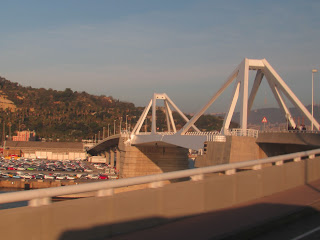Barcelona is the capital of the proud and distinct region of Spain called Catalunya. We have visited Barcelona once before on a cruise in 2011 and loved it. At that time we devoted our day to everything Gaudi, the artist/architect who is recognized as one of the greatest designers of the 19th and 20th centuries with his stained glass and towering, other-worldly buildings. The most famous work of Antoni Gaudi, the Sagrada Familia, is still under construction almost one hundred years after his death.
This time when we visit Barcelona, we wanted to go outside the town to Montserrat, home of Catalonia's most important religious retreat, hidden high in the craggy Montserrat Mountains. And we wanted to revisit some of the Gaudi sites, especially the Sagrada Familia to see how it has changed in the 4 years since our visit.
Our friend, Gay, found a tour that goes to both places so we joined her group of 16 people from the ship. The tour company was Pepito Tours and our guide, Jose Soler, was requested by Gay as she had him as a tour guide once before in Barcelona.
The ship was late in docking so we didn't start our tour until 9:00 am. It is a shorter day now than we even expected as we must be back on board by 4:30 pm.
We head out to Montserrat Mouintain and the Montserrat Benedictine Monastery Complex built high on the mountain nestled in the jagged peaks at 2,400 feet.
As we ascended the mountain, we left our sunny blue skies and went into a cloud. We could hardly see anything as we disembarked the bus.
Jose led us up to the entrance of the monastery, telling us a little about its history. The first hermit monks built huts at Montserrat about 900 A.D. By 1025, a monastery was founded and this has been Catalunya's most important pilgrimage site for a thousand years. And the clouds were beginning to lift...
 |
| Our guide, Jose Soler. |
Montserrat was one of the great monastic complexes of the Middle Ages, drawing monks and philosophers from far and wide. This courtyard is over a thousand years old, dating back to a time when religious hermits occupied the mountain caves.
We went into the basilica for a peek. It is decorated with statues of Christ and the 12 Apostles.
And then we joined the line to view the Black Virgin. It is a gilded wooden sculpture of Catalonia's patron saint La Morenta, also known as the Black Madonna or Black Virgin of Montserrat.
We both touch Mary's orb with one hand and held the other hand up to show that we have accepted Jesus.
Then it was time to take a few photos of the jagged peaks of the mountain since the fog had lifted and we had some blue sky.
These jagged peaks were the inspiration to Gaudi for the spires on the Sagrada Familia.
Minutes later it was covered in fog again. We felt fortunate to catch a clear glimpse of the mountain.
We headed back down toward the bus parking area, stopping by the vendors to buy some delicious rosemary goat cheese and a baguette...this will be our lunch as we head back to Barcelona.
Once back into the city of Barcelona, our next stop was the Sagrada Familia, Gaudi's most famous and persistent work. It was started in 1883 and it is expected to be completed by 2026, which is 100 years after Gaudi's death.
The life of Christ is portrayed in elaborate sculptures on the 3 facades of the church--the Nativity, the Passion, and the Glory.
Upon entering the nave of the church, we are in awe with the beauty of the mosaics and the sun making them shine like jewels.
The nave is so huge, it is hard to get a photo to capture it all. With all the columns, it looks like a forest of trees. Part of Gaudi's religious vision was a love for nature. He said, "Nothing is invented; it's written in nature,"
 |
| the ceiling |
The models of the church are kept here along with photographs taken during the various phases of construction.
This photo above shows how much of the building was completed at the time of Gaudi's death in 1926.
On the way out, we had just a few more minutes to admire the exterior facade.
With our time fleeting away, we headed over to Parc Guell, Gaudi's intended housing project but it turned into a colorful park. It was fun to see the terrace again with the colorful mosaic bench that snakes around the terrace.
We worked our way down to the front entrance of Parc Guell.
This is where we entered the park back in 2011. I remember it being a jaw-dropping experience as we exited our taxi and looked up into the park.
It was then time to leave and return to the ship. Not nearly enough time was spent at these sites, but we did enjoy seeing Montserrat for the first time and Sagrada Familia and Parc Guell for a second time. Jose was a great guide and did his best to show us the sites we requested in the short amount of time we had available.
If you are interested in seeing how we toured Barcelona on our own back in 2011, here is the link: Barcelona 2011
If we are lucky enough to return to Barcelona some day, we definitely will do the siteseeing on our own rather than a tour so that we can spend enough time at the sites to fully appreciate and understand them.
Next we leave the Mediterranean Sea and head across the Atlantic, stopping at one more port....The Azores.
















































No comments:
Post a Comment